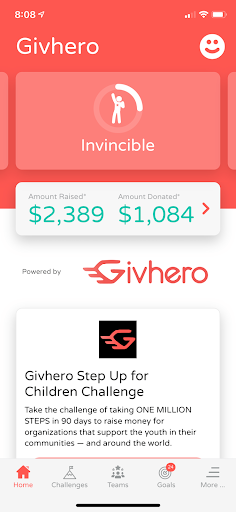
An effective employee wellness program delivers invaluable benefits to your organization: increased employee productivity, reduced healthcare costs, improved office morale, and more. Yet these benefits hinge on proper preparation and design. Implementing a wellness program at work involves conducting assessments, establishing a wellness committee, setting wellness goals, and more. With careful planning, and support from Givhero’s digital health and wellness platform, your employees’ well-being can soar.
Use the following steps to organize and implement an employee wellness program in the new year:
Conduct Assessments
Employee wellness arises from the fulfillment of employee needs. So, start crafting your company’s wellness program by identifying your employees’ concerns and interests. The best way to do so is to conduct workforce assessments.
You have several assessment tools to choose from. For instance, the CDC offers resources to design employee surveys, particularly ones that assess individual health needs. Their model provides a useful starting point, but you should write questions for your employees specifically. Another helpful assessment tool is health risk assessments (HRAs), which measure employees’ physical and mental health concerns.
You might also use organizational assessments to investigate which programs would suit employees across departments. From a business perspective, organizational assessments help determine which programs deliver the greatest ROI. Plus, you can combine its data with that of other assessments to generate responsive wellness program goals and objectives.
Seek Management Support
Management’s backing will be critical for your organization’s wellness program to succeed. Despite this fact, you may be wary of approaching them on the topic because a wellness program represents a significant investment. In light of this, you must convince your organization’s leadership that the program’s value justifies its costs.
To do so, you might discuss how wellness initiatives can fit within your organization’s goals. For example, you can tie socially responsible giving to creating a positive brand image. Also, if your organization aims to take on and retain clients, you should urge management to support employee health. Their investment can reduce turnover, increase productivity, and improve company culture.
To illustrate how the costs translate into benefits, create a sample wellness program proposal. Doing so also gives you an idea of the funding exigencies and policy adjustments involved with an employee health and wellness program.
Establish a Wellness Committee
While your organization’s leadership has the final say in all aspects of the wellness program, you should create an employee-run wellness committee. Sometimes called an employee resource group (ERG), this internal committee functions as a hands-on resource and organizational tool for workplace wellness culture.
Composed of either volunteers or appointees, a wellness committee can ensure your wellness program is inclusive. It can evaluate wellness program offerings, assess employees’ evolving needs, solicit feedback from the workforce, and—most importantly—help promote office wellness efforts.
Including staff of all backgrounds and communicating wellness benefits for employees are complex and sensitive challenges. Such tasks are best suited for wellness committees since they include a cross-sectional representation of your staff. Moreover, where an individual’s efforts can be limited by social determinants of health, a group can overcome the barriers presented by language, socioeconomic status, education, and accessibility.
Set Goals and Evaluate Progress
Using employee assessment data, management input, and wellness committee feedback, set wellness program goals and objectives. These may differ between organizations, but some common goals include:
- Increasing office performance and productivity
- Improving employee health in a given metric (weight, body fat percentage, blood pressure, sleep, etc.) or activity through a health challenge (active minutes, step challenge, meditation sessions, etc.)
- Boosting employees’ reported morale and job satisfaction
- Advancing employee health education with wellness classes and/or coaching
- Reaching a certain amount of charitable donations for non-profits
To evaluate your program’s success, you must have data to refer to; Givhero’s digital platform can assist in that very task. Our fully automated health and wellness app can tally employees’ daily progress toward wellness goals then provide management and individuals with customized reports. It also allows employees to select charities for their company to donate to as they complete wellness goals and challenges.
Givhero provides actionable information to increase and retain employee engagement in health initiatives. Plus, as their efforts contribute to charitable causes, employees simultaneously enjoy wellness benefits.
Design Wellness Program Components

With goals set and leadership installed, your organization can iron out the components of its wellness program. As with goals, programs differ between organizations based on their staff, resources, and circumstances. Nevertheless, popular workplace wellness programs examples include:
- Stress management through daily meditation or journaling
- Health screenings with clinicians
- Weight loss/management with daily exercise
- Social engagement through volunteer and charitable giving
- Emotional support through peer counseling and employee assistance programs (EAPs)
You should also consider the incentives behind your programs. Some organizations offer gift cards or company merchandise for employee participation. However, Givhero can help you leverage employees’ intrinsic motivators. These internal drivers of action—such as causes and competition—are their own reward and produce individual and social wellness success.
Givhero Makes Implementing a Wellness Program at Work a Surefire Success!
In the new year, you can transform your organization by implementing a wellness program at work with Givhero’s support. Our social wellness app allows businesses to create and manage wellness challenges, incentivizing employee engagement through intrinsic motivators. With our platform’s functionality, your employees can work in a happier and healthier environment while your organization enjoys greater productivity, reduced healthcare costs, and improved office morale. To learn more, call us at (240) 801-5927 or schedule a call now!

